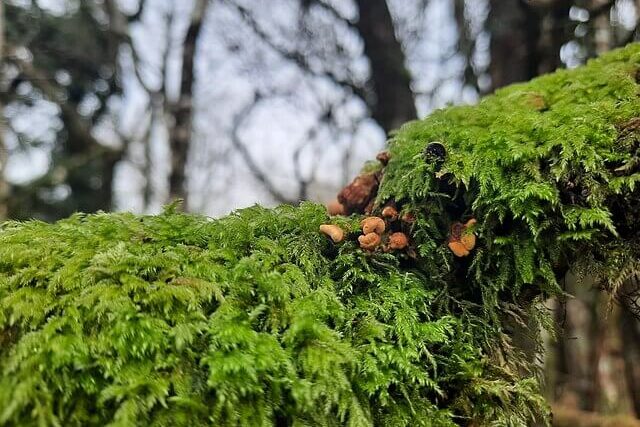
Even at midsummer, the ancient hazelwoods on the Hebridean island of Seil remain cool and hushed. Countless slanting hazel stems form a dense canopy that blots out the sunlight, casting the forest floor into what biologist Bethan Manley of the Society for the Protection of Underground Networks (Spun) describes as a “fairytale darkness”.
Branches carpeted in moss and lichen are threaded with honeysuckle, creating a great living dome overhead, adds David Satori, a researcher at the Royal Botanic Gardens, Kew.
This woodland on Scotland’s Hebridean islands is a surviving remnant of one of Britain’s oldest forest habitats. When the last Ice Age ended, glaciers a mile thick melted away and hazelnuts took root across the bare rock left behind.
“That’s older than any pine forest [in the UK]. Older than any ancient oakwood that we have down south,” Satori says. “One of the oldest woodlands in the British Isles.”
Scientists can trace the spread of these forests along Britain and Ireland’s western seaboard, explains Satori, because “around 10,000 years ago, you see a massive spike in hazel pollen”. Scottish lichenologists estimate that these particular woods may date as far back as 7,500 BC.
Today, only a few fragments of ancient hazelwood remain. Satori and Manley are here at Ballachuan Hazelwood, a 49-hectare (121-acre) reserve, to study what may be Scotland’s finest surviving example.
From outside, the thicket seems so ordinary it could easily be overlooked. But within, dead branches hang eerily and, as Satori notes, “stubby orange finger-like structures grip the hazel stems” – signs of rare fungi.
Among them are the glue crust fungus, which binds hazel branches together, and the parasitic “hazel gloves”, which protrude like grotesque growths. These fungi are central to the researchers’ work: understanding how fungal communities may hold the key to restoring Britain’s lost hazelwoods, part of a global effort to chart the hidden, underground half of the world’s forests.
In recent years, Britain has begun to recognise its status as a rainforest nation. Its rain-drenched western woodlands are a distinct form of temperate rainforest, surviving only in Scotland. Inspired by Guy Shrubsole’s bestselling The Lost Rainforests of Britain, the government has pledged to restore these ecosystems, which now cover less than 1% of land in Great Britain.
New research led by Leeds University suggests UK could play a globally significant role in reversing the decline of these rainforests. Temperate rainforests are vanishingly rare, occupying less than 1% of Earth’s land and thriving only in cool, damp conditions increasingly threatened by climate change. The study warns that as much as two-thirds could disappear worldwide, with Austria projected to lose up to 90%. Yet the UK and Ireland, with their rain-soaked, unforested expanses, could become “global leaders in restoration and reforestation of temperate rainforest”.
Forest regeneration depends heavily on mycorrhizal fungi, which live in symbiosis with tree roots, exchanging nutrients. Across Europe these fungi have suffered steep declines, but when trees are planted in soils rich with healthy fungal life, growth of tress and other plants is stimulated by 64%.
The challenge is that little is known about this subterranean world. “Hardly anything has been done to understand these communities,” says Satori. Some three-quarters of fungi are “dark taxa” – known only from DNA sequences, without physical specimens ever being collected.
Over the next two years, Satori will be sampling soils at Ballachuan and more than 20 other rainforest sites to create the first map of mycorrhizal communities across Britain’s temperate rainforests. Using a coring device, he extracts root tips and soil for environmental DNA (eDNA) analysis, providing a broad picture of the fungal networks beneath the hazels.
The project is backed by Spun, founded in 2021 to study and protect mycorrhizal fungi. Work on Seil links Scotland’s ancient woods to rainforests as far afield as Colombia and Palmyra Atoll, the world’s most remote island, as part of a global mapping initiative recently published in the journal Nature.
In Colombia’s Magdalena Valley, Spun researchers are investigating whether soils in cattle pastures retain rainforest fungal communities or have shifted permanently. On abandoned farmland, they are monitoring whether areas rich in fungal life regenerate more quickly, identifying the most promising sites for reforestation.
The UK faces an even steeper challenge, notes Manley. While Colombian land was cleared in recent decades, parts of Scotland have been treeless for perhaps a thousand years, leaving little fungal life to support new growth and making young trees more vulnerable to drought and stress.
Across the British Isles, rainforest restoration projects are now emerging. At Bowden Pillars in Totnes, the Devon Wildlife Trust (DWT) is developing a 30-hectare “rainforest creation” site. Volunteers have already planted over 2,500 trees, but soil analysis has been commissioned to assess the land’s ecological legacy, explains Claire Inglis, a reserve officer at DWT. The long-term goal is natural colonisation by seeds and fungi, as Inglis says: “Natural colonisation is always your most resilient option for future woodland.”
Some organisations, including DWT and the National Trust, are also trialling more hands-on interventions, such as “inoculation” – adding soil from intact ecosystems or transplanting fungal spores when planting trees.
“In the right circumstances, restoring degraded soils with inoculants can play an important role,” says Felicity Roos, a soil consultant with the National Trust. But commercial biofertilisers marketed as containing mycorrhizal spores are problematic: studies show the majority of products contain dead or ineffective spores, and some harbour pathogens.
Such efforts highlight why protecting ancient sites like Ballachuan is vital. These remnants serve as refugia – reservoirs of fungi that can spread across surrounding landscapes of farmland, semi-natural habitat and developed land.
Because much of the UK’s temperate rainforest exists in scattered fragments owned by different landholders, restoration will also require reconnecting habitats to form ecological corridors. As Satori puts it, these bridges are essential not just for fungi, but for animals and insects to move across the land.
“Having these interconnected landscapes is definitely going to be the best way to move forward,” he says. “It’s very much a long-term vision.”
——————————————————————————
At Natural World Fund, we are passionate about restoring habitats in the UK to halt the decline in our wildlife.

